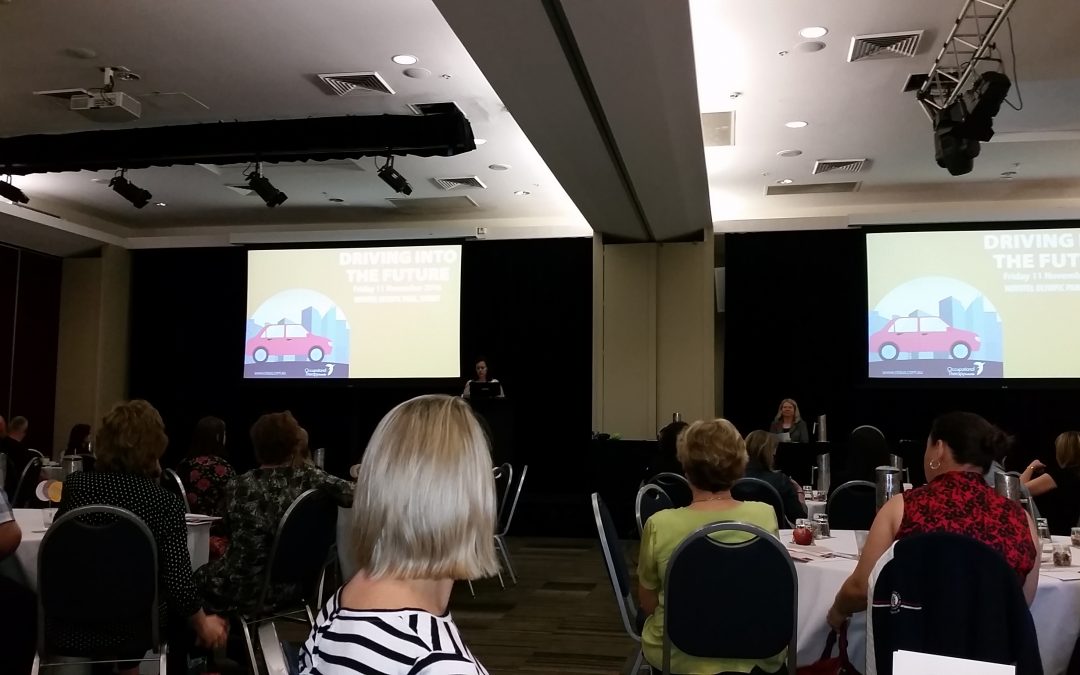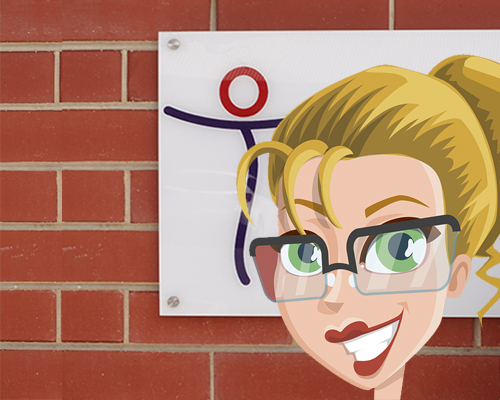2016 Driving Forum
On the 11th of November 2016, Occupational Therapy Australia held a driving forum in NSW. It was a great day where we got free giveaways like pens, stress balls, tape measures and even a torch.
But more importantly, we had the opportunity to hear about many new things in the field of driving and got to look again at leading vehicle conversions and vehicle controls.
This blog post will cover some of the interesting topics covered for your general information, and highlight what we learnt from a Williams OT perspective.
The psychological impact of car crashes: managing PTSD and the loss of driving.
Dr Chris Basten highlighted many important facts to consider when assisting clients with Post Traumatic Stress Disorder after a motor vehicle accident. We are happy to say that at Williams OT, we are implementing many of these strategies in our driver rehab already.
What we understand is that a driver assessment is stressful and can trigger many responses. Heightened anxiety from being assessed can be substantial. However, if the drive brings to attention issues associated with a motor vehicle accident, this can bring to the surface many behaviours that limit independence. These can be avoidance of driving of certain circumstances, re-experiencing the accident, or an autonomic arousal.
Did you know that 13.1% of the population suffer PTSD after an accident and 6.6% have a driving phobia? The good news is that more than 50% of original PTSD symptoms resolve in 1 year without treatment, however, a small percent of suffers get increased symptoms as time passes and there is a percentage that suffers delayed onset.
Treatment for PTSD is around cognitive behaviour training with exposure techniques, and understanding that stress is a normal response to an issue. We challenge the irrational response to the stress and ask what happens if you avoid driving situations? We recognise improvements and achievements through exposure. At Williams OT we take this further with the introduction of defensive driving skills to enhance a positive response to the return to driving.
Occupational Therapy driving assessments for clients with high level, complex physical impairment.
Tom Eley, Michelle Turnbull and Lyndall Cook presented the process of how to assess and provide intervention for very complex issues. The good news is that this is nothing new for Williams OT. We already work with complex issues and driving. We understand in full the process of how to assist a client when they do not have sufficient limb power to control steering or the pedals for brake and accelerator. In fact, we have a blog post coming out soon about a driver that has been through this process. Watch for an upcoming post about Nick who does not have the function in his arms and hands to control a steering wheel, even with a spinner knob, and only one working lower limb for pedal control. We will discuss how Nick moved through the process that was presented in this talk.
How to determine when a mentally ill brain injured person can drive.
Dr Patricia Jungfer held a fascinating talk around mental health conditions and driving. When mental health conditions are associated with a brain injury, this becomes very interesting. Currently, there is little to no evidence of driving outcomes.
With mental health conditions, health status can change from month to month or week to week. It can lay dormant for months on end, and then flair up without pre-warnings. Drivers can be in remission, but either due to the direct issues associated with the medical condition, or, secondary to their medications, brain power can be impacted upon. So how do you determine medical fitness to drive a motor vehicle? Is it appropriate to assess a driver on one given day? This has not yet been determined.
We do however know that if you have a diagnosed mental health condition, you are 2.5 times more likely to have an accident. When you consider that only about 10% of the population with a mental health condition actually get diagnosed and receive treatment, this can relate to large crash statistics.
Depression
Dr Jungfer reported that with the condition Depression, the condition can impact on attention, processing information, psychomotor performance and concentration. She also cited a study that found that 60% of clients being discharged from hospital after acute depression would not pass a practical driver assessment. That is alarming.
Personality disorders
Personality disorders impact on impulsivity, aggression, and irresponsibility. Mix this with a car, the outcomes could be significant.
ADHD
ADHD (attention deficit hyperactivity disorder) has been shown to influence inattention, impulsivity, risk-taking behaviours and reduce processing speed.
Substance abuse
Substance abuse impacts on multiple levels, however, the impact of the substance reduces personal awareness of the secondary issues. Therefore drivers may not be aware of their deficits on road.
Mental health medications
When we consider medications to assist overcome mental health conditions, older style antipsychotics cause brain power (cognitive) delays with decreased arousal. We know that only 35% of drivers pass an on-road assessment when taking such medications. Modern antidepressants have increased arousal, but issues in divided attention present. Antianxiety medications such as benzodiazepines have an associated increased risk of accidents.
Many more studies need to be undertaken and it appears that Dr Jungfer will initiate some of this research. In the meantime, it is important to know that Williams OT implements best practice guidelines, or what there is of it, for mental health conditions. Our experience in the area is that there can be significant cognitive delays in speed of processing and divided attention in some cases. Yes, conditions fluctuate, however, if, when the client is in remission, and there are issues in on road performance, we can advise accordingly. We understand the importance of getting to know the client and whether their condition is major or a secondary condition to another medical issue. We investigate how the secondary condition impacts on the major condition and we ask, will treatment change the outcome.
Driving Simulator use in OT driver assessments and rehabilitation.
Pamela Ross provided an insight into the process she went through to gain a simulator for Epworth Hospital in Victoria. She outlined that not all simulators are the same. Ranging from $20,000 to $100000US for a basic to moderate simulator, there is no perfect answer for the best option. There are significant differences in realism and scenarios available. Screen sizes and viewing areas are significantly different. Simulators also cause issues with nausea and this is more significant in older drivers and women. Furthermore, simulators have not yet been proven to replace a real life on-road assessment.
Despite these issues, simulators can be used with significant success in rehabilitation, preparing for driving, trialling driver aids, and improving self-awareness.
What is good to know, is that Williams OT is aware of 2 simulators in Adelaide and we are currently investigating options to link into these for rehabilitation purposes.
KEYNOTE: Driving towards the future: a Snapshot of current research and considerations for future projects
Presented by Professor Carolyn Unsworth, the presentation highlighted the importance of making the right clinical decisions regarding a client’s medical fitness to drive. It highlighted that all research has to assist Occupational Therapists to make correct judgments. Judgements need to lead to the right decisions, and away from incorrect judgments that allow the driver to continue to drive but continue to be a medical risk on the road, or, judgment to revoke someone’s ability to drive when they are indeed safe. Significant research is going into tools to assist in this clinical judgment. It is good to know that Williams OT is already implementing leading assessment tools and that we don’t just rely on one tool. The Williams OT battery of tools is amongst the highest validated tools available to predict driving performance. If you are an OT involved in driving, you can assist with current research around judgement by completing the survey at this site https://cisbic.bioinformatics.ic.ac.uk/fitness_to_drive_decision_aid/
Recent findings are suggesting that a second assessment does not change outcomes.
Also, findings are suggesting that clients without navigational problems were more likely to pass a local route compared to an open route. Also, although data is still being collected, initial data suggests that clients with navigational problems can perform at a higher standard when following verbal directions around a set, compared to an open route, even if in their own area. Williams OT will watch this space, but our anecdotal evidence would agree with these findings. Our assessments will have a self-navigation task where possible to look at the client’s ability to self-direct driving.
Automated or driverless cars was an interesting topic of conversation. We know that there are goals by car companies to have driverless cars on our roads by 2020. What does this mean for a driver with a disability? If a car can drive a client without physical power to control pedals or steering wheel, this will create new levels of freedom for clients with significant disabilities. But, how will the liability be determined? If there is an accident, who is at fault, the company that made the electronics for the car, the car company, the driver?
Where to from here?
This is just a snapshot of some of the talks presented. It was rewarding to see that Williams OT is abreast of the majority of current trends and research/evidence. New items learnt will be implemented into practice.
If you would like to know more, we will be having a blog post soon highlighting a client’s story with complex physical medical concerns. We also hope to have guest blog posts from some of the presenters. I also recommend that you leave comments and questions at the bottom of this post. If we don’t know the answer we will endeavour to find out for you. I encourage you to leave comments, or join us for our regular teleconferences to discuss out some of these highights in more details.
About the Authors:
Pamela Ross has worked as an occupational therapist in the area of rehabilitation for over 30 years. She has specialised in return to work and driver assessment and rehabilitation, with specific expertise in traumatic brain injury and multi-trauma. She is currently employed as a senior clinician at Epworth Healthcare, where she manages and works clinically in both the vocational and driver rehabilitation programs. She has presented at many conferences and is also a presenter for the Community Mobility Program for Older Drivers, aimed at raising awareness in older drivers about remaining safe behind the wheel and transport alternatives to driving. Pam has recently completed a PhD investigating ‘Return to Driving after Traumatic Brain Injury’. She is a member of a research team based at Monash University, Melbourne, which has collaborated with researchers in Canada on a project comparing simulator performance and results of cognitive tests with on-road assessment outcome. In 2015, Pam was awarded a Churchill Fellowship to investigate the clinical use of driving simulators with older and disabled drivers. In April/May 2016, she travelled to France, UK, Canada and the USA, where she visited driving programs that use driving simulators and met with researchers to learn about the evidence for their use with medically impaired drivers.
Chris Basten is a Clinical Psychologist with particular interests in health psychology, including adjustment to illness and injury. Starting more than 20 years ago, he worked for many years at Westmead Hospital in consultation-liaison psychiatry. There, he consulted to the orthopaedic and plastics wards and saw many people with road and industrial trauma. He has collaborated in research articles about PTSD. For several years now he has worked in his own practice and training psychologists and other health professionals. Chris consults to the Osseointegration Group of Australia, where he assesses and supports amputees. He has published papers on and participated in research into adjustment to trauma, adaptation to loss of limb and the predictors of depression with chronic illness (diabetes).
Dr Patricia Jungfer is a graduate of the University of Sydney and a Fellow of the Australian New Zealand College of Psychiatrists. Dr Jungfer completed her speciality training at the Westmead Hospital and in 1990 was a Research Fellow at the NSW Institute of Psychiatry, examining the “Psychiatric effects of Acquired Brain Injury”. In the past, Dr Jungfer has held Staff Specialist and Visiting Medical Officer positions in Western Sydney and rural NSW. She currently practises in Burwood, in the inner west of Sydney. Her clinical work focuses on the management of psychiatric and behavioural disorders following all forms of acquired brain injury; however neurological disorders with white matter pathology are a particular focus.
Tom Eley is an Occupational Therapist, in private practice since 2000 and working in the field since qualifying in 1986. His main interest is vehicle prescription and adapted vehicle controls for people with significant physical disabilities including spinal cord injury, complex orthopaedic injuries and congenital disabilities. He is an OT driving assessor, a driving instructor, and a Paravan accredited driving instructor for people learning to use electronic vehicle controls. He is also a qualified motor mechanic.
Michelle Turnbull graduated from the University of Sydney in 1996. She has worked as an Occupational therapist since that time with experience in both the public and private sectors. Michelle trained as a driver trained occupational therapist in 1999, and established the Driving Assessment and Rehabilitation Service at the Bankstown-Lidcombe Hospital in 2003. Michelle completed her Masters degree in 2008 with her research looking at return to driving outcomes following stroke, and she is a past chairperson of the OT Australia NSW Driving Focus Group. Michelle currently works privately completing driving assessments and vehicle modification assessments with a particular area of interest in working with high-level spinal cord injury clients who drive from their wheelchairs.
Carolyn Unsworth is Professor of Occupational Therapy at Central Queensland University and holds Adjunct Professorial appointments at La Trobe University and Curtin University in Australia and Jönköping University, Sweden. Her research focuses on enabling people with age-related health declines or disabilities to access the community through driving a car or using powered wheelchairs or mobility scooters. Carolyn also conducts research in the areas of clinical reasoning and decision making, outcomes measurement and evidence-based practice. Carolyn has authored over 130 journal articles and book chapters as well as developing two published assessments on; driver assessment (called the OT-DORA), and a global outcome measure (called the AusTOMs-OT).



